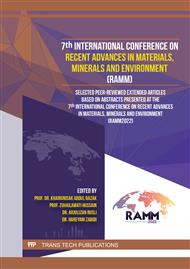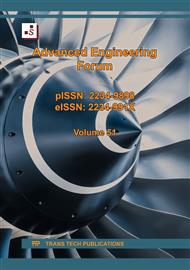[1]
M. R. Miah et al., "Polypyrrole-based sensors for volatile organic compounds (VOCs) sensing and capturing: A comprehensive review," Sensors Actuators A Phys., vol. 347, no. September, p.113933, 2022.
DOI: 10.1016/j.sna.2022.113933
Google Scholar
[2]
N. Jia Yam, A. Rusli, Z. A. Abdul Hamid, M. K. Abdullah, and K. I. Ku Marsilla, "Halochromic poly (lactic acid) film for acid base sensor," J. Appl. Polym. Sci., vol. 138, no. 13, p.1–11, 2020.
DOI: 10.1002/app.50093
Google Scholar
[3]
S. A. Alias et al., "Halochromic polybutylene adipate terephthalate (PBAT) for acid base sensor," Mater. Today Proc., vol. 66, p.2883–2888, 2022.
DOI: 10.1016/j.matpr.2022.06.551
Google Scholar
[4]
S. Farah, D. G. Anderson, and R. Langer, "Physical and mechanical properties of PLA, and their functions in widespread applications — A comprehensive review," Adv. Drug Deliv. Rev., vol. 107, p.367–392, 2016.
DOI: 10.1016/j.addr.2016.06.012
Google Scholar
[5]
J. Domínguez-Robles et al., "Antioxidant pla composites containing lignin for 3D printing applications: A potential material for healthcare applications," Pharmaceutics, vol. 11, no. 4, p.5–7, 2019.
DOI: 10.3390/pharmaceutics11040165
Google Scholar
[6]
T. P. Mpofu, C. Mawere, and M. Mukosera, "Impact and application of 3D printing technology," Int. J. Sci. Res., vol. 3, no. 6, p.2148–2152, 2014.
Google Scholar
[7]
ASTM International, "ASTM D638: Standard Test Method for Tensile Properties of Plastics," 2014.
Google Scholar
[8]
M. C. Cichero and J. H. Z. dos Santos, "Encapsulated bromocresol purple-based sensitive materials: The role of the nature and distribution of matrix layers on ammonia sensing performance," Appl. Surf. Sci. Adv., vol. 4, no. February, p.100078, 2021.
DOI: 10.1016/j.apsadv.2021.100078
Google Scholar
[9]
H. Khanjanzadeh and B. D. Park, "Covalent immobilization of bromocresol purple on cellulose nanocrystals for use in pH-responsive indicator films," Carbohydr. Polym., vol. 273, no. March, p.118550, 2021.
DOI: 10.1016/j.carbpol.2021.118550
Google Scholar
[10]
C. Swaroop and M. Shukla, "Mechanical, Optical and Antibacterial Properties of Polylactic Acid/Polyethylene Glycol Films Reinforced with MgO Nanoparticles," Mater. Today Proc., vol. 5, no. 9, p.20711–20718, 2018.
DOI: 10.1016/j.matpr.2018.06.455
Google Scholar
[11]
P. Wojciechowska, "The Effect of Concentration and Type of Plasticizer on the Mechanical Properties of Cellulose Acetate Butyrate Organic-Inorganic Hybrids," Recent Adv. Plast., no. March 2012, 2012.
DOI: 10.5772/35350
Google Scholar
[12]
B. W. Chieng, N. A. Ibrahim, W. M. Z. W. Yunus, and M. Z. Hussein, "Poly(lactic acid)/poly(ethylene glycol) polymer nanocomposites: Effects of graphene nanoplatelets," Polymers (Basel)., vol. 6, no. 1, p.93–104, 2014.
DOI: 10.3390/polym6010093
Google Scholar
[13]
K. Yuniarto, Y. A. Purwanto, S. Purwanto, B. A. Welt, H. K. Purwadaria, and T. C. Sunarti, "Infrared and Raman studies on polylactide acid and polyethylene glycol-400 blend," AIP Conf. Proc., vol. 1725, no. October 2017, 2016.
DOI: 10.1063/1.4945555
Google Scholar
[14]
R. Nasrin et al., "Preparation of Chitin-PLA laminated composite for implantable application," Bioact. Mater., vol. 2, no. 4, p.199–207, 2017.
DOI: 10.1016/j.bioactmat.2017.09.003
Google Scholar
[15]
M. Ghorbani et al., "A halochromic indicator based on polylactic acid and anthocyanins for visual freshness monitoring of minced meat, chicken fillet, shrimp, and fish roe," Innov. Food Sci. Emerg. Technol., vol. 74, no. September, p.102864, 2021.
DOI: 10.1016/j.ifset.2021.102864
Google Scholar
[16]
C. Gamerith et al., "pH-responsive materials for optical monitoring of wound status," Sensors Actuators, B Chem., vol. 301, no. August, p.126966, 2019.
DOI: 10.1016/j.snb.2019.126966
Google Scholar
[17]
J. M. Reverte, M. ángel Caminero, J. M. Chacón, E. García-Plaza, P. J. Núñez, and J. P. Becar, "Mechanical and geometric performance of PLA-based polymer composites processed by the fused filament fabrication additive manufacturing technique," Materials (Basel)., vol. 13, no. 8, 2020.
DOI: 10.3390/MA13081924
Google Scholar
[18]
J. Andrzejewski, K. Grad, W. Wiśniewski, and J. Szulc, "The use of agricultural waste in the modification of poly(Lactic acid)-based composites intended for 3d printing applications. the use of toughened blend systems to improve mechanical properties," J. Compos. Sci., vol. 5, no. 10, 2021.
DOI: 10.3390/jcs5100253
Google Scholar
[19]
M. Bijarimi, S. Ahmad, R. Rasid, M. A. Khushairi, and M. Zakir, "Poly(lactic acid)/Poly(ethylene glycol) blends: Mechanical, thermal and morphological properties," AIP Conf. Proc., vol. 1727, no. July 2018, 2016.
DOI: 10.1063/1.4945957
Google Scholar



